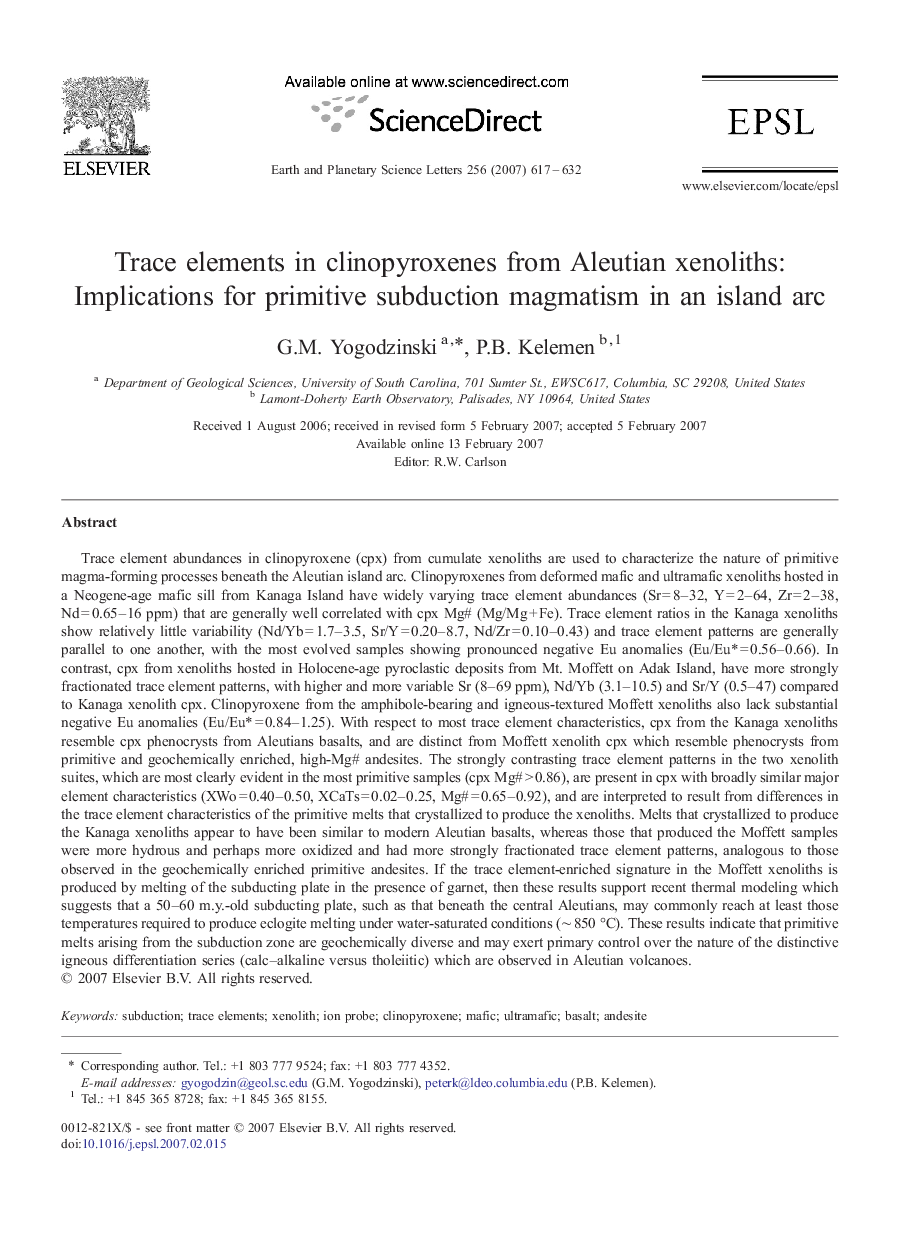| Article ID | Journal | Published Year | Pages | File Type |
|---|---|---|---|---|
| 4680606 | Earth and Planetary Science Letters | 2007 | 16 Pages |
Trace element abundances in clinopyroxene (cpx) from cumulate xenoliths are used to characterize the nature of primitive magma-forming processes beneath the Aleutian island arc. Clinopyroxenes from deformed mafic and ultramafic xenoliths hosted in a Neogene-age mafic sill from Kanaga Island have widely varying trace element abundances (Sr = 8–32, Y = 2–64, Zr = 2–38, Nd = 0.65–16 ppm) that are generally well correlated with cpx Mg# (Mg/Mg + Fe). Trace element ratios in the Kanaga xenoliths show relatively little variability (Nd/Yb = 1.7–3.5, Sr/Y = 0.20–8.7, Nd/Zr = 0.10–0.43) and trace element patterns are generally parallel to one another, with the most evolved samples showing pronounced negative Eu anomalies (Eu/Eu⁎ = 0.56–0.66). In contrast, cpx from xenoliths hosted in Holocene-age pyroclastic deposits from Mt. Moffett on Adak Island, have more strongly fractionated trace element patterns, with higher and more variable Sr (8–69 ppm), Nd/Yb (3.1–10.5) and Sr/Y (0.5–47) compared to Kanaga xenolith cpx. Clinopyroxene from the amphibole-bearing and igneous-textured Moffett xenoliths also lack substantial negative Eu anomalies (Eu/Eu⁎ = 0.84–1.25). With respect to most trace element characteristics, cpx from the Kanaga xenoliths resemble cpx phenocrysts from Aleutians basalts, and are distinct from Moffett xenolith cpx which resemble phenocrysts from primitive and geochemically enriched, high-Mg# andesites. The strongly contrasting trace element patterns in the two xenolith suites, which are most clearly evident in the most primitive samples (cpx Mg# > 0.86), are present in cpx with broadly similar major element characteristics (XWo = 0.40–0.50, XCaTs = 0.02–0.25, Mg# = 0.65–0.92), and are interpreted to result from differences in the trace element characteristics of the primitive melts that crystallized to produce the xenoliths. Melts that crystallized to produce the Kanaga xenoliths appear to have been similar to modern Aleutian basalts, whereas those that produced the Moffett samples were more hydrous and perhaps more oxidized and had more strongly fractionated trace element patterns, analogous to those observed in the geochemically enriched primitive andesites. If the trace element-enriched signature in the Moffett xenoliths is produced by melting of the subducting plate in the presence of garnet, then these results support recent thermal modeling which suggests that a 50–60 m.y.-old subducting plate, such as that beneath the central Aleutians, may commonly reach at least those temperatures required to produce eclogite melting under water-saturated conditions (∼ 850 °C). These results indicate that primitive melts arising from the subduction zone are geochemically diverse and may exert primary control over the nature of the distinctive igneous differentiation series (calc–alkaline versus tholeiitic) which are observed in Aleutian volcanoes.
